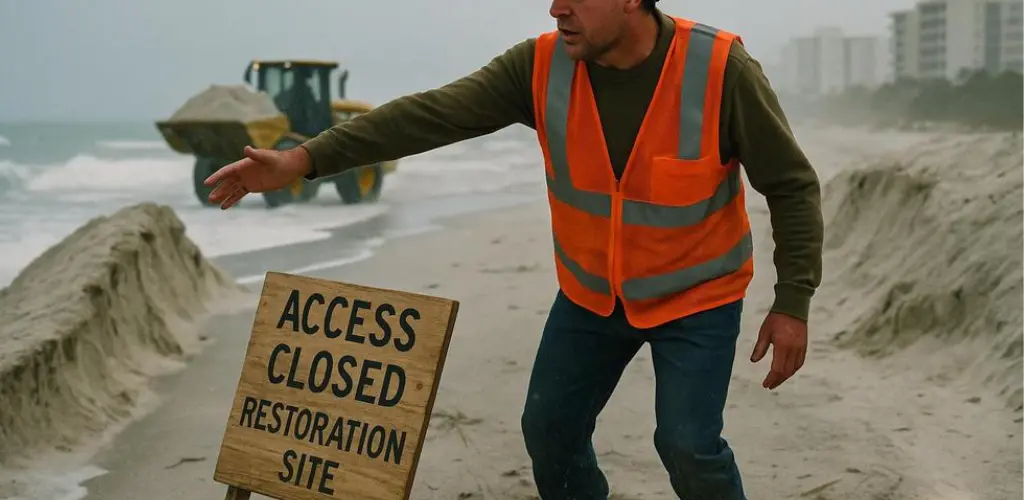The City of Sarasota has announced a $12 million federally funded project to restore and reinforce 1.2 miles of coastline along Lido Beach, marking a significant step in its long-term strategy to safeguard Florida’s Gulf Coast from worsening erosion, rising sea levels, and future storms. With work scheduled to begin in late 2025, the large-scale beach renourishment effort will deposit up to 300,000 cubic yards of sand — equal to about 23,000 dump truck loads — followed by the construction of a resilient vegetative dune system to shield beachfront infrastructure and preserve coastal biodiversity.
Combating Erosion, One Grain of Sand at a Time
Lido Beach has experienced decades of shoreline loss exacerbated by hurricanes and tropical storms, leading to significant damage to dunes, public access points, and waterfront properties. Some areas have lost up to 100 feet of beach width due to recent storm events. In response, the City of Sarasota, in collaboration with Sarasota County and the U.S. Army Corps of Engineers, is implementing the second phase of a federal beach protection program first launched in 2021.
“This is an essential investment in the stability and safety of our coastal community,” said Mayor Liz Alpert in a recent statement. “We’re grateful to our federal partners for helping us both protect this vital resource and enhance our economic future.”
A Two-Stage Plan for Long-Term Coastal Protection
The Lido Key project will unfold in two phases:
- Beach Renourishment: Scheduled to begin following October 31, 2025 — after the close of sea turtle and shorebird nesting seasons — this phase involves dredging up to 300,000 cubic yards of sand from nearby New Pass, a federal navigation channel. The new sand will fortify the beach’s width and elevation, providing immediate protection against storm surges and erosion.
- Vegetative Dune System: In late 2026, crews will begin shaping new dunes up to 6.6 feet above sea level south of Lido Beach Pavilion. These natural barriers will be stabilized with native flora including sea oats and dune sunflowers to reduce wind erosion and absorb storm energy. Completion is expected by spring 2027.
According to City Engineer Nikesh Patel, the dual approach of sand placement followed by native dune restoration reflects a “science-based and sustainable response to the complexities of coastal change.”
Balancing Environmental Needs With Infrastructure Goals
Sensitive to its ecological impact, the city coordinated timing with both Mote Marine Laboratory and the Sarasota Audubon Society to avoid disrupting the critical nesting seasons of sea turtles and migratory birds — a longstanding priority for Lido Beach, one of Florida’s key nesting zones.
Unlike artificial seawalls that harden the shoreline, the renourishment and dune plan embrace a more natural solution, one that not only absorbs wave energy but restores wildlife habitat. The new dunes will function as both buffers and biodiversity corridors, enhancing the area’s native resilience over time.
Tourism, Recreation, and Property at the Forefront
Lido Beach is central to Sarasota’s identity as a coastal destination. By replenishing the beach, the project aims to preserve its draw for tourists and residents alike. The wider, safer beach also serves as a vital buffer, helping shield residential developments and high-value condominiums from storm damage — protections that may bolster property values and strengthen investor confidence.
Beyond financial metrics, the improved beach experience supports Sarasota’s $2.8 billion tourism industry, sustaining local businesses ranging from restaurants to beachfront rental services. Enhanced public access and scenic vistas are expected to draw both first-time visitors and seasonal residents back to the shore for years to come.
Improved Navigation at Sea and Safety on Land
Dredging sand from the New Pass federal navigation channel will remove excess sediment that has accumulated since the last major storm season, restoring safer conditions for vessels entering and exiting Sarasota Bay. As a result, the project doubles as both a coastal maintenance operation and a vital upgrade for boaters and commercial fishing operations.
On shore, planners have committed to minimizing construction disruptions. During both dune and sand work, crews will maintain public beach access points wherever possible, install safety signage, and provide regular online updates. Public input has played a role, with an informational meeting held March 26, 2025, to explain project logistics and address community questions.
A Strategic Response to a Shifting Climate
This latest phase marks more than a stopgap — it is part of a larger commitment to resilient shoreline planning amid mounting environmental threats, including climate-induced sea-level rise. With storms growing stronger and more frequent, coastal municipalities across Florida face greater urgency to invest in forward-looking infrastructure.
Officials say Lido’s blend of natural and engineered protection positions Sarasota as a leader in this effort. With financial backing from the federal government, the city is building not only a stronger beach, but a more durable future.
Project Timeline
- March 26, 2025: Public informational meeting held
- Late 2025 (post Oct. 31): Sand placement begins
- Early 2026: Sand renourishment completed
- Late 2026: Vegetative dune construction starts
- Spring 2027: Full project completion expected
Modeling Coastal Stewardship Through Partnership
The Lido Beach renourishment project exemplifies a multifaceted response to a multifaceted problem — blending engineering, ecology, and economics in a timeline-driven framework. Its success will be measured not just in cubic yards moved or dunes shaped, but in the city’s long-term confidence that its beaches, homes, habitats, and industry are better prepared for the tides of tomorrow.
As Mayor Alpert noted, “This project is about preserving more than land — it’s about preserving a way of life for Sarasota and its future generations.”



